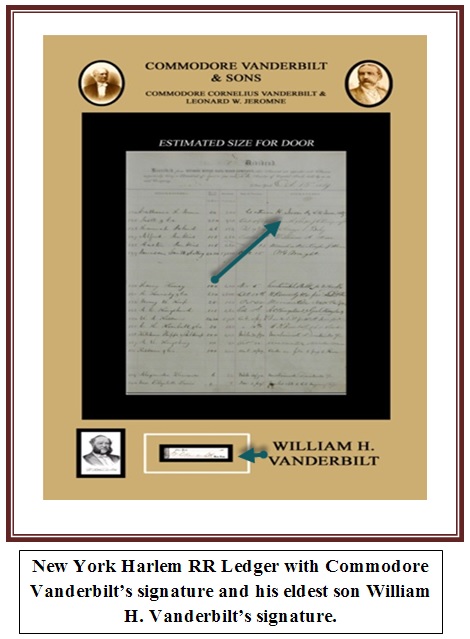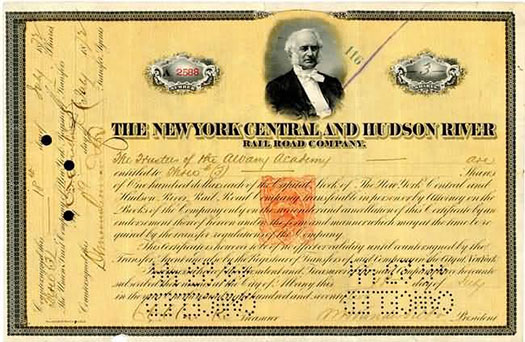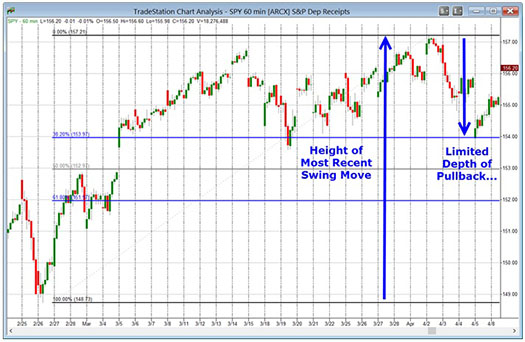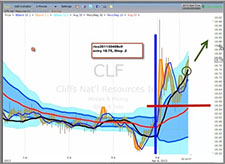Tharp's Thoughts Weekly Newsletter (View On-Line)
-
Article Commodore Vanderbilt and the Money Game, by Van K. Tharp, Ph.D.
-
-
Trading Tip Everyone Leans One Way... by D.R. Barton, Jr.
-
Ken's Class Take professional losses as part of your trading
-
 Purchase Trading Beyond the Matrix Purchase Trading Beyond the Matrix
from The Van Tharp Institute!
We are proud to announce that you can now purchase Van's newest book, Trading Beyond the Matrix: The Red Pill for Traders and Investors, directly from The Van Tharp Institute. We will continue to offer many discounts and bonuses with your purchase. For more information about the book, click here. To purchase Trading Beyond the Matrix from The Van Tharp Institute for $29.95, click here.

Commodore Vanderbilt and the Money Game
by Van K. Tharp, Ph.D.
View On-line
I think Commodore Vanderbilt is the perfect example of how the money game is successfully played. When the Commodore died, he was worth about $105 million, translating to about 1.53% of the total GDP of his day. Various estimates, adjusted for inflation, put him anywhere from 2nd to 6th among the wealthiest Americans ever. 
First, let me address some generalities about Vanderbilt’s life. Money and competition seemed to be everything to him. Vanderbilt and his wife, Sophia, had 13 children, but only three sons. Vanderbilt’s wife, Sophia, ran a boarding house and with her earnings she was expected to care for and educate all of the children. The Commodore actually lived on one of his ships for most of his early life.
He loved his family and did them many favors. Many of his sons-in-law were involved in running his businesses. However, Vanderbilt’s primary concern was in preserving his legacy.
He remarked that none of his shares would be sold after his death. Before his death, the Commodore gave away many shares of stock and much of his land to his son William H. Vanderbilt and to William’s sons. Although he provided for all 13 of his children in the will, William got the bulk of the estate. William’s son, Cornelius, who was the Commodore’s favorite grandson, was groomed to run the financial empire after William’s death.
The Commodore’s life was one financial battle after another, battles which he seldom lost. Even when he did lose, he always managed to get his money back or get revenge on the other party. If you had bet against Vanderbilt’s businesses, most of the time, you would have lost big. Vanderbilt had immense staying power and somehow always managed to come out on top.
Vanderbilt always paid for everything with cash, he never used leverage. This was one of the reasons he survived while many around him were going bankrupt trying to do similar things with borrowed money.
Vanderbilt knew nearly every prominent person of his era and that included a lot of wealthy people. Most were his friends, some were even former enemies. So networking, in an indirect way, was very important. At his peak, Vanderbilt personally met with Buchanan, Lincoln, Johnson and Grant. He had great influence over what they did.
The Commodore was ruthless. Two of his most famous quotes include:
- “What do I care about the law? Ain’t I got the power?”
- To his steamship rivals Charles Morgan and Cornelius Garrison: “Gentlemen: You have undertaken to cheat me. I won’t sue, for the law is too slow. I’ll ruin you.”
At one point, he personally funded an effort to end a war in Central America involving a number of countries. In doing so, he accomplished what the U.S. government could not.
Later, he was accused of manslaughter, but never even saw the inside of a jail. In fact, before the court proceedings even started, Vanderbilt and his family set sail for Europe on one of the biggest ships built to date, the North Star. His son-in-law, Horace Clark, handled the legal work for that case and everything was dismissed before the Commodore returned from his four month sailing journey.
As the Commodore grew in business, so did the concept of the corporation. Originally, when a project was too big for a single person to handle, a corporation would be formed in order to finance it. People thought of the corporation as having some par-value represented by the initial startup costs and that the primary concern of the corporation was its dividends. Vanderbilt, however, grew to understand the corporation very well and started doing things that others might have thought of as unfair simply because he understood how corporations worked. For example, he would often settle a deal by agreeing not to enter into any other competition. Those deals were always agreed with a handshake. He would never sign a written document. People soon discovered that, while he would not compete against them personally, the agreement didn’t stop him from competing against them though one of his corporations.
And finally, his business philosophy could be summarized by a quote he made in an 1869 court testimony: “How do I make a profit? I make it by the savings of expenditures. If I cannot use the capital of that road (meaning railroad) better per year than anyone else who has ever been in it, then I do not want to be in the road. That has been my principle with steamships: but if I could not run a steamship alongside another man and do it as well as he for 20 percent less than it cost him, I would leave this ship”
The Commodore’s life might be said to be comprised of four phases: 1) Early Ferryboat Days; 2) Thomas Gibbons Apprenticeship; 3) Ruling the Ocean Routes as the Commodore; and 4) The Railroad King. During each phase there were numerous battles, all interesting, which the Commodore usually won.
Early Ferryboat Days
Vanderbilt’s parents were humble, but instilled a strong entrepreneurial sense in him. His father used his sailboat as a ferry and to salvage cargo from shipwrecks. His mother loaned money and even foreclosed a mortgage she had extended to her own daughter, after her daughter was widowed. Starting in 1810 at the age of 16, Vanderbilt operated a sailboat, technically owned by his parents. Later, he married his first cousin, Sophia Johnson, and began to work entirely for himself. It was said that he got married simply to become independent of his parents. He ran a ferry between Manhattan and Staten Island and began to trade in cargoes of fish, produce and goods. He was a big man, over six feet tall, who learned to use his fists as well as his brain. He was tough, honest and capable, and he knew when to break the rules.
Thomas Gibbon’s Apprenticeship
In 1817, Vanderbilt agreed to serve as a ferry captain for Thomas Gibbons of New Jersey, while still operating his own boats. He agreed to do this because Gibbons’ vessel (which ran between New Jersey and New York) was a steamboat, giving Vanderbilt an education in this new technology. Most importantly, Vanderbilt assisted Gibbons in a battle against a legal monopoly on steamboats in New York waters that had been granted to the patrician Livingston family. In those days, rich families were often granted monopolies in new technologies and the steamboat was a prime example of that. Vanderbilt frequently ran against the law for Gibbons. In fact, the law in New Jersey was on Gibbon’s side while that of New York was on Ogden’s, who had been granted the license to operate a steamship by the Livingston family.
In 1824, Chief Justice John Marshall of the US Supreme Court ruled against the monopoly granted by NY saying that states could not interfere with interstate commerce. Had the verdict gone the other way, Vanderbilt would have probably gone bankrupt and been thrown in jail for his many violations of earlier court rulings. However, the ruling allowed Gibbon’s ferry to operate without any problems and that opened up Vanderbilt’s future in transportation.
Vanderbilt understood that the speed of information in his time could only move as fast as the fastest form of transportation. So, as technology advanced, Vanderbilt adapted by moving from ships, to steamships, to advanced steamships, to railroads, and eventually he even controlled the early telegraph.
Vanderbilt worked for Thomas Gibbons until Thomas’ death in 1826, and then for his son William Gibbons until 1829, but all the while continuing to operate his own ships on the side. His aggressiveness caused Thomas Gibbons to write, “I am afraid of this man.”
The Commodore
Vanderbilt was always designing and building larger and faster steamers, becoming one of the leading maritime architects of the paddlewheel era. After leaving Gibbons’ service, he inaugurated a series of lines radiating out of Manhattan—first to New Brunswick, NJ then to Peekskill, Albany, and the ports on Long Island Sound. He competed against the dominant steamboat enterprises in each market, offering better speed and lower fares. At times, he accepted pay-offs to end his competition; and he paid at least one rival, Daniel Drew, to do the same.
Starting in 1835, Vanderbilt concentrated on Long Island Sound, where his boats connected to the new railroads that served Boston and New England’s budding factory towns. He acquired a stake in a number of these railways and took part in their management. In 1847, with the aid of Daniel Drew (an ally by that point), he took control of the Stonington railroad, and was elected corporate president.
During the Gold Rush, there was a great migration of Americans to California. Remember, the fastest transportation was the fastest form of information transfer. To go to California, you could go across the country by wagon train, taking a year, or you could go by ship around South America — or perhaps via a water and land route through Panama or Nicaragua. Vanderbilt immediately moved into this field, even winning the government mail route to the Pacific. He would operate one set of ships for the Atlantic part of the route and the other set for the Pacific.
Vanderbilt’s wanted to construct a canal across Nicaragua which was already largely traversed by natural waterways. Nicaragua was closer to the US than Panama, and a canal there would be cheaper and faster than his competition who were crossing through Panama. He was unable to secure the necessary capital for the canal from British bankers, but he was able to convince the Nicaraguan government to grant his company the exclusive right to transport passengers and freight from ocean to ocean. Displaying his ever-present sense of adventure, he personally went to Nicaragua three times in order to scout the canal and transit routes, negotiate with the government, and pilot steamboats across Lake Nicaragua. Inaugurated in July 1851, Vanderbilt’s line, known as The Accessory Transit Company, soon became an effective competitor with the established Panama route, carrying passengers between New York and San Francisco at lower fares. The route saved nearly a week of travel time compared to the journey via Panama, and several months off a voyage around Cape Horn. The success of the Nicaragua route lifted Vanderbilt to national prominence. He acquired the informal title of Commodore—then the highest rank of the U.S. Navy—an honorific description used by newspapers, politicians, and family members for the rest of his life.
The Accessory Transit Company’s success led to a succession of conflicts with partners in the enterprise. In 1856, after a hiatus outside of the company, partly to take a celebrated journey with his family to Europe, Vanderbilt resumed control, only to run up against William Walker. Walker was a soldier of fortune who had invaded foreign countries and in 1855, managed to take control of Nicaragua. In doing so, he stripped Accessory Transit of its transit rights, transferring them to a friend of Walker’s, who resold them to Vanderbilt’s business rivals. Soon, a war developed involving a number of countries, which the United States was powerless to stop. Vanderbilt personally developed and financed a plan to overthrow Walker’s regime. After Walker was gone, however, the new Nicaraguan government refused to reopen the transit route. Again, showing his toughness and tendency to never lose, Vanderbilt started a new line running by way of Panama. Ultimately he forced Pacific Mail to divide the market with him and establish a joint monopoly in 1860.
During this period, Vanderbilt also engaged in other enterprises.
- On May 21, 1855, he initiated a transatlantic steamship line, in opposition to a federally subsidized company led by Edward K. Collins. As usual, his line offered steeply lower fares, and Collins’s company eventually went bankrupt.
- After many prior ventures into ferries between Manhattan and Staten Island, he started the service that is the direct ancestor of the municipal Staten Island Ferry that is in operation today.
- During the Civil War, Vanderbilt donated his largest steamship to the Union Navy. The Union was afraid that the ironclad, famously known as the Merrimack, would destroy Union shipping. However, Vanderbilt’s ship, the Vanderbilt, was able to hold the ironclad at bay and stop it from doing more damage until it was later destroyed. After the war was over, Congress awarded him a gold medal for his service.
The Railroad King
It is remarkable that Vanderbilt was able to see that the railroad would become the king of transportation in the latter part of the nineteenth century. As a result, he sold all of his steamship businesses and moved into railroads where he became the King.
Vanderbilt’s interest was first drawn to the New York & Harlem Railroad, which went right into the center of Manhattan. Once he acquired that, he took control of a series of railroads that connected New York to Chicago—moving sequentially into:
- The Hudson River,
- The New York Central,
- The Lake Shore & Michigan Central, and
- The Canada Southern.
He created an interregional railroad system. This was a major transformation of the railroad network, which had previously been fragmented into numerous short railroads, each with its own procedures, timetables, and rolling stock. The creation of a coherent system spanning several states lowered costs, increased efficiency and sped up travel and shipment times.
Vanderbilt was ruthless in his business tactics. For example, in January 1867, he halted all rail traffic going into Manhattan to settle a business dispute. A winter storm was preventing ferries from reaching the city at that time so his action essentially cut off New York from the rest of the country. Such acts aroused fierce debate over the new power of corporations, and about the inherent conflicts between private and public interests created by very large enterprises. Vanderbilt saw no such conflicts. As he explained his philosophy to the New York State legislature, “It is not according to my mode of doing things, to bring a suit against a man that I have the power in my own hands to punish.” The New York Times created the metaphor (if not the actual phrase) of “the robber baron” in order to criticize Vanderbilt’s style of business.
In 1863 and 1864, Vanderbilt cornered the market in Harlem railroad shares in order to punish short-selling public officials who wished to damage the stock price. In 1868, he waged an epic, yet failed attempt to corner Erie Railway stock. Jay Gould, Daniel Drew and James Fisk bribed the New York State legislature to enable them to print more and more stock, which they sold to Vanderbilt. The Commodore lost $7 million in this venture, but was later able to force Gould to give much of it back. Many assumed that Vanderbilt was paying off public officials as well, though evidence was lacking.
In 1870, Vanderbilt consolidated his two core companies into one of the first giant corporations in American history: the New York Central & Hudson Railroad. The new company had a par-value stock capitalization of about $100 million, roughly four times greater than that of the New York Central alone just a few years earlier. The par-value of each share was $100, a figure of great importance to nineteenth-century investors. In theory, the total par-value of a company's stock represented its investment in physical capital.
Cornelius Vanderbilt ordered the construction of new infrastructure, including the original Grand Central Depot (then the largest railroad station in the United States), a massive freight depot at St. John’s Park in lower Manhattan, and an unprecedented four-track corridor between Albany and Buffalo. Within the city of New York, Vanderbilt was eventually forced to move his railroads underground.
The New York Central & Hudson River was able to continue to issue regular dividends after the cataclysmic Panic of 1873, when other major railroads suspended payment and half of the nations’ railways went bankrupt.

Stock of the New York Central and Hudson River with Vanderbilt’s Picture
Even though Vanderbilt had little education and spelled phonetically, he was one of the first to really understand the power of corporations. He carried out some of the first notable stock splits, later rewarded with rising share value on the stock market. Conventional economic thinkers, on the other hand, denounced these splits as "stock watering." In keeping with the theory of the day, they believed that the shares of stock should equal the amount of investment in physical capital, usually at $100 per share, the standard par-value. If new shares did not represent a corresponding increase in real estate, buildings, rolling stock and the like, then they were condemned as "fictitious capital." Vanderbilt, however, usually increased the dividend payment after such splits to make investors happy. Vanderbilt defended his operations in conventional terms, but he contributed to the abstraction of the financial sector, decoupling securities from a direct linkage to the physical world.
Corporate collusion to eliminate competition was another issue that surrounded Vanderbilt during his later years.
- Vanderbilt dominated railroads, although he was later surpassed in that by Jay Gould.
- Rockefeller and Standard Oil Trust dominated the oil industry.
- Carnegie dominated the Steel Industry.
- And J. P. Morgan later dominated railroads, steel, and electricity.
Vanderbilt had celebrated competition as a steamboat entrepreneur, but when he went into railroads he tried to construct cartels to set rates and manage conflicts across the industry. He was attacked by numerous critics, including Mark Twain.
Vanderbilt was very liberal in his business attitudes in his early years, espousing laissez faire views of Adam Smith, even though he probably had not read The Wealth of Nations. Although his views never changed, by the time he died, Vanderbilt was actually considered very conservative. In 1867, when testifying before the New York State legislature, Vanderbilt said: “I have always served the public to the best of my ability…Why? Because, like every other man, it is to my interest to do so.” This is pure Adam Smith philosophy.
Summary: The Money Game as Played By Cornelius Vanderbilt
1) Money was more important than anything else to him, including his family.
2) He thrived on competition and his life was one battle after another.
3) He broke the rules continuously, even though he was pretty honest and straight forward in terms of his word. If he said something, he stood buy it. However, when he said he wouldn’t compete against you, and then did so as a corporation, he really wasn’t breaking his word, he was bending the rules.
4) He knew most of the influential people of his era and was able to use them to further his interests.
5) He determined the latest advances in technology (in this case transportation) and was always at the forefront. He contributed greatly to the advancement of the United States and in doing so became one of the wealthiest men ever.
About the Author: Trading coach and author Van K. Tharp, Ph.D. is widely recognized for his best-selling books and outstanding Peak Performance Home Study Program—a highly regarded classic that is suitable for all levels of traders and investors. You can learn more about Van Tharp at www.vantharp.com. His new book, Trading Beyond The Matrix, is available now at matrix.vantharp.com.
Trading Education
Workshops
Be sure to take action and register for any workshop you are interested in attending. We have several that are sold out with a waiting list.
April 19-21
April 22-24 |
Day Trading Workshop with Ken Long — SOLD OUT
Live Day Trading Sessions with Ken Long |
May 17-19 |
Swing Trading with Ken Long
|
May 21-23 |
Forex Trading with Gabriel Grammatidis
|
June 20-22 |
Peak Performance 101
We expect this workshop to sell out this week, register soon to reserve your seat. |
June 24-27 |
Peak Performance 202 — SOLD OUT
|
Jun 29-Jul 1 |
Peak Performance 203 — SOLD OUT
|
July 13-14 |
Core Trading Systems
Longer Term Trading Systems
|
To see the schedule, including dates, prices, combo discounts and location, click here.
This month, we expect to make a decision on whether or not Van will be teaching in Berlin, Germany in September. Once we know, we can set the workshop schedule for August-November 2013.
We always have our Super Trader Summit in December.
Back to Top
Trading Tip
When Everyone Leans One Way...
by D.R. Barton, Jr.
View On-line
We are through the first weekend of April, and as we fully enter the month with showers that bring May flowers, I was struck by one thing. Amongst my reading over the weekend, I was constantly reminded of how in the last three years, the market has hit a high in April, which started big pullbacks of 10 to 19 percent. Barrons, Wall Street Journal, and even some trusted friends with blogs and articles are all writing about it.
Long-suffering readers of this column know that I just had to go back and count. I found 11 instances of April warnings, without even really looking. Between the market struggling to gain its footing and writing this article on Monday morning (4/8), it looks like the bears just might have their way. But when too many think the same thing (and talk about it on TV and write about it incessantly), my “uh-oh” detector goes off.
Logically, I agree with all of them. This grinding bull market that has been with us since November is getting, as my grandpa used to say, a little long in the tooth. You’ve probably heard the statistics: Since the November swoon, we haven’t even had a 4 percent pullback. That’s a long time for the market to go without any corrective action to speak of. But, there are always two sides to every story, and this one is no different.
The Other Side of the Story – Why Markets Exist
I’ve had various traders tell me a similar philosophy of markets — paraphrasing: markets move to inflict pain on the maximum number of participants. Now, that is, of course, the cynical view. But beneath that briny exterior, I believe the thought actually captures a deeper truth.
Markets exist to facilitate trade. That means making it easier for buyers and sellers to transact. Well-run, high-volume markets (like the stock market) provide low transaction costs and tight bid/ask spreads. Given these conditions, more people are willing to transact more often. Compare that to less efficient markets, like real estate or used car sales where higher costs of transaction and wider bid/ask spreads mean that participants don’t trade in and out as often. Well-run markets allow price to become a volume seeking mechanism. Which is why, at times, the market seems to go where most people will be forced to transact (puke up their trade or investment) and hence, the cynical view of some traders that the market seeks “pain points.” This is also why sentiment analysis and overbought /oversold indictors can be useful — there are times when too many people are trapped and the market price will move to find the maximum volume — when those trapped traders and investors have to give up their positions.
In today’s market, there is a longer-term, upward pressure from players who don’t want to miss the next up leg, so they keep pouring money into the market (Lipper shows a more than $74 billion net inflow into equity funds in the first quarter of 2013). This is currently being balanced by all those folks busily looking, in the shorter-term, for a market correction or pullback.
My analysis says that in the intermediate to longer-term time horizon, the trapped money is on the long side — all of those who have come late to the party, hoping to catch a ride on the bull run that is already old and getting older. Those players are going to get slammed by a significant pullback, but not until the short-term players get trapped by one more frantic push to the upside.
Those expecting a pullback thought it started last week. However, looking at the drop numerically, it was merely a very mild reset in a longer-term grinding bull. Take a look at this chart of hourly data that shows the depth of the pullback relative to the last 6 weeks of trading:

As you can see, the market did an almost perfect 0.382 Fibonacci retracement of its recent swing drive up. In general, this type of mild pullback leads to more movement in the direction of the trend. And that move, if it comes as expected, will catch those who are trying to get in early on an April swoon.
As always, your comments and feedback are welcome! Please send them to drbarton “at” vantharp.com
Great Trading,
D. R.
About the Author: A passion for the systematic approach to the markets and lifelong love of teaching and learning have propelled D.R. Barton, Jr. to the top of the investment and trading arena. He is a regularly featured guest on both Report on Business TV, and WTOP News Radio in Washington, D.C., and has been a guest on Bloomberg Radio. His articles have appeared on SmartMoney.com and Financial Advisor magazine. You may contact D.R. at "drbarton" at "vantharp.com".
Disclaimer
Ken's Class
 In this 12 minute video, Ken relates how he started his day slowly on Monday, April 8 with a quick losing trade. Then he took a series of trades on declining volatility and an upward trending price on a leveraged index ETF. At the end of the day, his series of trades had netted +10R. Some of Ken’s conclusions from this Trade of the Day video — Take professional losses as part of your trading. Cash them when you have them in a trade you don’t believe in strongly. Let the trend work when price finds support where it’s supposed to. In this 12 minute video, Ken relates how he started his day slowly on Monday, April 8 with a quick losing trade. Then he took a series of trades on declining volatility and an upward trending price on a leveraged index ETF. At the end of the day, his series of trades had netted +10R. Some of Ken’s conclusions from this Trade of the Day video — Take professional losses as part of your trading. Cash them when you have them in a trade you don’t believe in strongly. Let the trend work when price finds support where it’s supposed to.
Click Here to Watch the Video
News from Van
Updates to the Super Trader Program
The Super Trader Program will have a new pricing structure, beginning this July. For more information, click here.
Podcasts and Interviews Featuring Dr. Van Tharp
Lately, Van has been talking about his new book, Trading Beyond the Matrix on various radio shows and podcasts. We have archived these and past interviews here so that you can listen!
Ask Van...
Everything we do here at the Van Tharp Institute is focused on helping you improve as a trader and investor. Consequently, we love to get your feedback, both positive and negative!
Click here to take our quick, 6-question survey.
Also, send comments or ask Van a question by clicking here.
Back to Top
Contact Us
Email us at [email protected]
The Van Tharp Institute does not support spamming in any way, shape or form. This is a subscription based newsletter.
To change your e-mail Address, e-mail us at [email protected].
To stop your subscription, click on the "unsubscribe" link at the bottom left-hand corner of this email.
How are we doing? Give us your feedback! Click here to take our quick survey.
800-385-4486 * 919-466-0043 * Fax 919-466-0408
SQN® and the System Quality Number® are registered trademarks of the Van Tharp Institute
Be sure to check us out on Facebook and Twitter!
 
Back to Top |
|
April 10, 2013 #624

Our Mission
Viewing on-line eliminates spacing, and formatting problems that may be unique to your email program.

A Must Read for All Traders
Super Trader
How are we doing?
Give us your feedback!
Click here to take our quick survey.
From our reader survey...
"I think the newsletter is extremely generous and it is a resource I utilize constantly. I have saved every single one since I first subscribed."
Trouble viewing this issue?
View On-line. »
Tharp Concepts Explained...
-
Trading Psychology
-
System Development
-
Risk and R-Multiples
-
Position Sizing
-
Expectancy
-
Business Planning
Learn the concepts...
Read what Van says about the mission of his training institute.
The Position Sizing Game Version 4.0
Have you figured out yet how to pick the right stocks? Are you still looking for a high win-rate trading system? When you’re ready to get serious about your trader education, download the Position Sizing Game to learn some true fundamentals of trading success. Learn more.
To Download for Free or Upgrade Click Here

Download the 1st three levels of Version 4.0 for free.
Register now. »
Trouble viewing this issue?
View On-line. »

A Thousand Names for Joy: A Commentary
You can read Super Trader Curtis Wee's full review here.
Dr. Tharp is on Facebook

Follow Van through
Twitter »
Van Tharp Trading Education Products are the best training you can get.

Check out our home study materials, e-learning courses, and best-selling books.
Click here for products and pricing
What kind of Trader Are You? Click below to take the test.
Tharp Trader Test
Back to Top

Introduction to Position Sizing™ Strategies
E-Learning Course
Only $149
Learn More
Buy Now
SQN® and the System Quality Number® are registered trademarks of the Van Tharp Institute
Dr. Tharp on Producing a Rarity with his limited edition Safe Strategies book.
Click to read more.
|